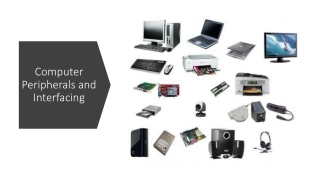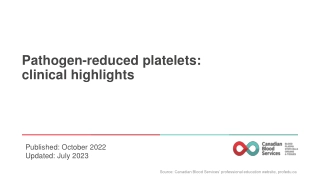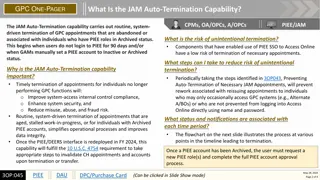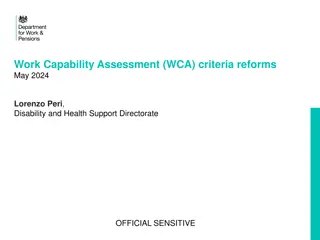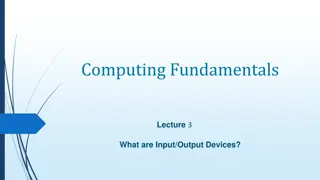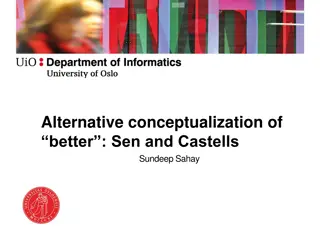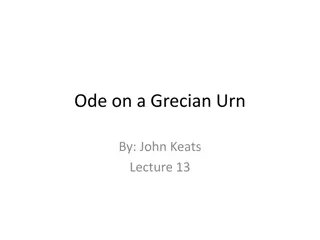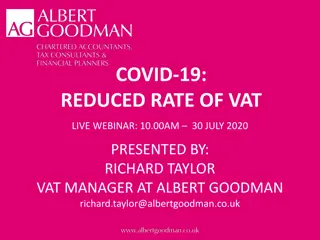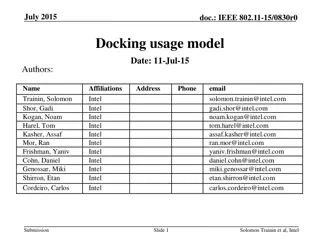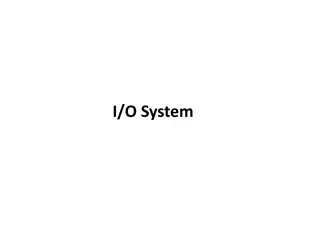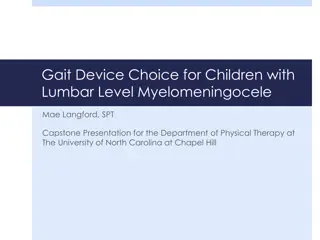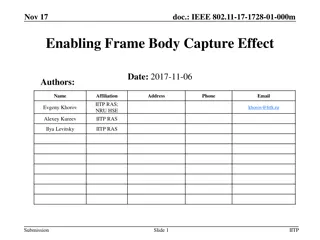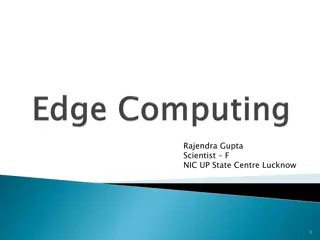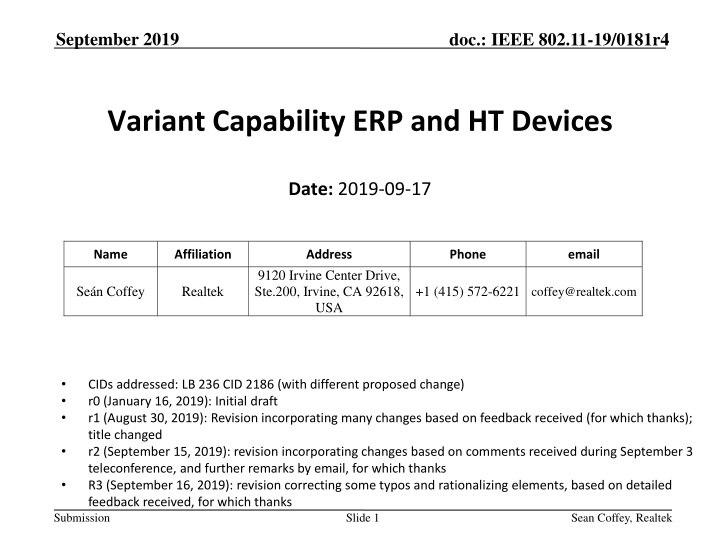
Variant Capability for Wi-Fi IoT Applications at 2.4GHz
"Explore the proposal for accommodating variant capability devices in IEEE 802.11 standards to better suit very low-power Wi-Fi IoT applications. Find out how this can enhance performance and efficiency in the design space while promoting Wi-Fi accessibility."
Download Presentation

Please find below an Image/Link to download the presentation.
The content on the website is provided AS IS for your information and personal use only. It may not be sold, licensed, or shared on other websites without obtaining consent from the author. If you encounter any issues during the download, it is possible that the publisher has removed the file from their server.
You are allowed to download the files provided on this website for personal or commercial use, subject to the condition that they are used lawfully. All files are the property of their respective owners.
The content on the website is provided AS IS for your information and personal use only. It may not be sold, licensed, or shared on other websites without obtaining consent from the author.
E N D
Presentation Transcript
September 2019 doc.: IEEE 802.11-19/0181r4 Variant Capability ERP and HT Devices Date: 2019-09-17 Name Affiliation Address Phone email 9120 Irvine Center Drive, Ste.200, Irvine, CA 92618, USA Se n Coffey Realtek +1 (415) 572-6221 coffey@realtek.com CIDs addressed: LB 236 CID 2186 (with different proposed change) r0 (January 16, 2019): Initial draft r1 (August 30, 2019): Revision incorporating many changes based on feedback received (for which thanks); title changed r2 (September 15, 2019): revision incorporating changes based on comments received during September 3 teleconference, and further remarks by email, for which thanks R3 (September 16, 2019): revision correcting some typos and rationalizing elements, based on detailed feedback received, for which thanks Submission Slide 1 Sean Coffey, Realtek
September 2019 doc.: IEEE 802.11-19/0181r4 Variant Capability ERP and HT Devices Date: 2019-09-17 Name Affiliation Address Phone email 9120 Irvine Center Drive, Ste.200, Irvine, CA 92618, USA Se n Coffey Realtek +1 (415) 572-6221 coffey@realtek.com CIDs addressed: LB 236 CID 2186 (with different proposed change) r0 (January 16, 2019): Initial draft r1 (August 30, 2019): Revision incorporating many changes based on feedback received (for which thanks); title changed r2 (September 15, 2019): revision incorporating changes based on comments received during September 3 teleconference, and further remarks by email, for which thanks r3 (September 16, 2019): revision correcting some typos and rationalizing elements, based on detailed feedback received, for which thanks) r4 (September 17, 2019): revision with editorial changes based on corrections received via email (for which thanks) and others Submission Slide 2 Sean Coffey, Realtek
September 2019 doc.: IEEE 802.11-19/0181r4 Abstract For very low power Wi-Fi IoT applications operating at 2.4 GHz, designers currently must choose between baseline 802.11 (DSSS), 11b (HR), 11g (ERP), and 11n (HT). Each poses problems: ERP devices are required to support 1, 2, 5.5, 11 HR/DSSS and 6, 12, and 24 Mbps rates: the OFDM rates are burdensome and the data rates are often overkill HT adds STBC (good), but also 8 more OFDM rates, extending to 65 Mbps (very bad) But DSSS- and HR/DSSS-only devices don t do any OFDM preamble detect, require single-tone protection modes, increasing time on air and lowering power consumption for all devices in the BSS, including themselves IoT applications and requirements are very heterogeneous, and Wi-Fi is widely perceived to be high power in this market segment. It would be useful, and it would help promote Wi-Fi, to widen the design space to allow variant ERP and HT devices. This presentation proposes a fully backwards compatible way of achieving this Submission Slide 3 Sean Coffey, Realtek
September 2019 doc.: IEEE 802.11-19/0181r4 Overview and summary An ERP or HT device that omits some higher data rate modes is indistinguishable from a device that implements all the modes but is operating at long range which is a scenario that has always been present The proposal permits non-AP STAs that operate at 2.4 GHz to implement any subset of rates that satisfies a streamlined set of requirements Just enough to mimic regular devices at long range 1 Mbps, 2 Mbps, 6 Mbps mandatory All other data rates optional (subject to requirement below) Data rate supported all otherwise mandatory lower rates of same type required STA associates as ERP or HT device no single-tone protection asked for or given Short (9 s) slot time mandatory Submission Slide 4 Sean Coffey, Realtek
September 2019 doc.: IEEE 802.11-19/0181r4 CID 2186 236 2 19.1.1 2949 10 It would be useful for several purposes to add an extra reduced- capability PHY, permitting implementers to choose a subset of PHY modes from the HR/DSSS, ERP, and HT PHYs. For some applications that have stringent constraints on complexity, such as many IoT applications, it might be useful to be able to implement a device that supports only the 1 and 2 Mbps HR/DSSS modes and the 6 Mbps ERP mode, for example (perhaps transmitting at 1 and 2 Mbps most of the time, but able to process 6 Mbps preambles). Or it might be useful to implement a device that implemented only the HR/DSSS rates, but also supported short slot time. At present, such devices would not be IEEE 802.11 compliant. An easy change to the specification would suffice to permit these variations. Interoperability should not be a problem since even a full HT device operating at long range might not be able to process PPDUs sent at any but the lowest rates, and this possibility has existed since the beginning. Submission Slide 5 Sean Coffey, Realtek
September 2019 doc.: IEEE 802.11-19/0181r4 Summary of r3 changes, versus r0 (1/4) 1. Added 6 Mbps OFDM as a mandatory rate This is the most significant change; a result of feedback received from multiple sources Adding this rate greatly simplifies coexistence and interoperability: these Class 2 devices will recognize all OFDM preambles and will be able to defer properly Requires implementation of an OFDM modem, when one motivation of the original proposal was to allow for the possibility of avoiding that but the fact that only 6 Mbps needs to be implemented maximizes implementer flexibility, and simplifies the requirements compared to a full OFDM modem (65 Mbps) 2. Changed the name RC-HT ( Reduced Capability HT) to Class 2 ERP-HT r0 incorrectly assumed that short (9 s) slot time was mandatory for all HT devices. In the March 2019 meeting, it emerged that this is not correct. Substantially all new HT devices shipped in (at least) the last 10 years have implemented short slot time, but it is still optional in the IEEE spec. The proposal retains the requirement that the new, variant, devices support short slot time, but this is now an additional requirement, so the new, variant, devices are not necessarily reduced capability any more. Submission Slide 6 Sean Coffey, Realtek
September 2019 doc.: IEEE 802.11-19/0181r4 Summary of r3 changes, versus r0 (2/4) 3. Added Class 2 ERP device r0 only had variant HT devices; one comment received was why no variant ERP? No reason, really: it can all work either way. On one hand it may be confusing to have an HT device that has no HT modes, but on the other, it adds complication to have to deal with two distinct new concepts. On the September 3 call, we discussed re-merging into one class (subset of ERP as a subset of HT). While that probably would be fine, there is a slight possibility of confusion if a legacy AP encountered a Class 2 HT device that did just 1, 2, 6 (would rate fallback from 6.5 Mb/s go directly to 1 Mb/s?). It seems a little cleaner to allow a 1, 2, 6 device to be Class 2 ERP. 4. Made mandatory support for short slot time in Class 2 ERP and HT devices explicit This was implied in the discussion in r0, but was assumed (incorrectly) to be implied by the requirement that otherwise the device satisfied all requirements of HT devices. Submission Slide 7 Sean Coffey, Realtek
September 2019 doc.: IEEE 802.11-19/0181r4 Summary of r3 changes, versus r0 (3/4) 5. Added requirement to support all otherwise mandatory data rates of same type (single tone or OFDM) lower than any supported rate r0 required all variant devices to support (DSSS) 1 and 2 Mbps, and (if any OFDM mode was supported) to support (OFDM) 6 Mbps The underlying logic for the proposal (r0, r1, and r2 versions) is that rate fallback will ensure backwards compatibility and interoperability: there should be no practical distinction between Class 2 devices (which don t implement higher modes) and regular devices at longer range (where the modes have been implemented but are not operational which happens all the time) It is conceivable that under the r0 proposal, a legacy implementation s rate fallback algorithm could be confused by the presence of gaps in the variant device s mandatory rates. Even this should be fine (at most it might cause occasional additional attempts at unsupported rates); but on the other hand it adds virtually no additional complexity to rule out the gaps. Submission Slide 8 Sean Coffey, Realtek
September 2019 doc.: IEEE 802.11-19/0181r4 Summary of r3 changes, versus r0 (4/4) 6. Added capability bits for the new functionality Based on feedback received on r0 Though legacy devices will not interpret these capability bits and should be fine anyway, newer APs will be able to figure out what s going on, and it may help manage their BSSs N.B.: no additional requirements are placed on APs as a result of these capability bits (unlike the analogous OMI case). It is useful to provide for an existing rate management scheme to be ported in its entirety from a legacy AP to a new AP, without having to worry about falling out of compliance. 7. Class 2 devices must follow full minimum receiver sensitivity if mode is supported In r0, minimum receiver sensitivity requirements were optional However, this (arguably) has a knock-on effect on CCA. For example, for OFDM the STA must be able to detect start of valid PPDU at power > -82 dBm with probability > 90% and defer for the indicated duration this requires the 6 Mbps L-SIG to be decoded. Minimum receiver sensitivity PPDU payload changed to 100 bytes rather than 1000 Same minimum receiver sensitivity requirements as for ERP & HT devices (change r1 r2) Submission Slide 9 Sean Coffey, Realtek
September 2019 doc.: IEEE 802.11-19/0181r4 Rates beyond 1, 2, 6 Mbps Rates beyond 1, 2, 6 Mbps still not required We discussed whether 5.5 and/or 11 Mbps, and even some other rates, should be added as requirements, on the basis that it is a common industry practice for APs to beacon at 5.5 Mbps for efficiency reasons even up to 24 Mbps But adding all of these modes would eliminate all of the rationale for this proposal, and adding some of them would eliminate most of it If your product must be able to associate with any possible AP, then you should design a dual- band 2.4 / 5 GHz ERP/OFDM, HT or VHT device (and soon you should design a tri-band device) The proposal allows for optimized, low power, low complexity IoT STAs to communicate with off-the-shelf APs--with any AP that is configured to beacon at 1, 2, or 6 Mb/s Also, we should be careful to preserve the full potential range of Wi-Fi IoT networks, down to 1 Mbps Strong feedback was received in 11mc that this is important, e.g., for competitive positioning Cementing 5.5 Mbps as an all-but-exclusive beacon rate would cut across this message APs should be able to beacon at 1 Mbps if they want to N.B. under r0-r4 APs will retain all rates that are currently mandatory Submission Slide 10 Sean Coffey, Realtek
September 2019 doc.: IEEE 802.11-19/0181r4 Proposed change 1/12 Add at end of first paragraph of 18.1.1 (General) (D2.0 2936.13): "In addition, a variant capability PHY based on the ERP ( Class 2 ERP") is defined in this clause. Submission Slide 11 Sean Coffey, Realtek
September 2019 doc.: IEEE 802.11-19/0181r4 Proposed change 2/12 Add new paragraph at the end of 18.1.2 (Introduction) (D2.0 2936.25): A non-AP STA is a Class 2 ERP STA if it satisfies all of the following requirements and is not an ERP STA: The STA shall operate in the 2.4 GHz band, and shall have operating channel width 20 MHz; (1) The STA shall support transmission and reception of DSSS 1 Mb/s and 2 Mb/s; (2) The STA shall support transmission and reception of ERP-OFDM 6 Mb/s; (3) If the STA supports HR/DSSS 11 Mb/s, then it shall support HR/DSSS 5.5 Mb/s; (4) If the STA supports ERP-OFDM 24 Mb/s then it shall support ERP-OFDM 12 Mb/s; (5) Subject to (4) and (5), each (non-DSSS) HR/DSSS, (non-6 Mb/s) ERP-OFDM, and HT data rate is optional; (6) The STA shall support transmission and reception of DSSS long preamble and short preamble; (7) The STA shall support short slot time; (8) The CCA functionality for ERP-OFDM in 18.4.6(a), (b) and for HT in 19.3.19.5.4 shall be supported; (9) The minimum receiver sensitivity requirements of Clauses 15, 16, 18, and 19 shall apply to all supported modes; Submission Slide 12 Sean Coffey, Realtek
September 2019 doc.: IEEE 802.11-19/0181r4 Proposed change 3/12 (11) A Class 2 ERP STA shall indicate support in the Supported Rates and BSS Membership Selectors element, and, if applicable, the Extended Supported Rates and BSS Membership Selectors element, during association and reassociation, and in probe requests, for (i) 1, 2, 5.5, 11, 6, 12, and 24 Mb/s (whether it supports all of these rates or not), and (ii) all ERP rates from the set 9, 18, 36, 48, and 54 Mb/s that the Class 2 ERP STA supports, and shall not indicate support for other ERP rates; (12) A Class 2 ERP STA shall transmit the Supplemental Class 2 Capabilities element; (13) In all other respects the STA shall follow the requirements of the ERP. NOTE--A Class 2 ERP STA will not be able to operate in a BSS whose AP includes in the basic rate set, and uses for transmission of group-addressed frames, only rates that the STA does not support. Submission Slide 13 Sean Coffey, Realtek
September 2019 doc.: IEEE 802.11-19/0181r4 Proposed change 4/12 Add at end of first paragraph of 19.1.1 (Introduction to the HT PHY) (D2.0 2941.10): "In addition, a variant capability PHY based on the HT PHY ("Class 2 HT PHY") is defined in this clause. Submission Slide 14 Sean Coffey, Realtek
September 2019 doc.: IEEE 802.11-19/0181r4 Proposed change 5/12 Add new paragraph at the end of 19.1.1 (Introduction to the HT PHY) (D2.0 2941.41): A non-AP STA is a Class 2 HT STA if it satisfies all of the following requirements and is not an HT STA: (1) The STA shall operate in the 2.4 GHz band, and shall have operating channel width 20 MHz; (2) The STA shall support transmission and reception of DSSS 1 Mb/s and 2 Mb/s; (3) The STA shall support transmission and reception of ERP-OFDM 6 Mb/s; (4) If the STA supports HR/DSSS 11 Mb/s, then it shall support HR/DSSS 5.5 Mb/s; (5) If the STA supports ERP-OFDM 24 Mb/s then it shall support ERP-OFDM 12 Mb/s; (6) If the STA supports any Nss = 1 HT MCS > 0, then it shall support all Nss =1 HT lower MCSs and all lower ERP rates; (7) Except as noted in (5), (6) and (7), each (non-DSSS) HR/DSSS and ERP-OFDM data rate and each HT MCS is optional; (8) The STA shall support DSSS long preamble and short preamble; (9) The STA shall support short slot time; (10) The CCA functionality for ERP-OFDM in 18.4.6(a), (b) and for HT in 19.3.19.5.4 shall be supported; (11) The minimum receiver sensitivity requirements of Clauses 15, 16, 18, and 19 shall apply to all supported modes; Submission Slide 15 Sean Coffey, Realtek
September 2019 doc.: IEEE 802.11-19/0181r4 Proposed change 6/12 (12) A Class 2 HT STA shall indicate support in the Supported Rates and BSS Membership Selectors element, and, if applicable, the Extended Supported Rates and BSS Membership Selectors Element, during association and reassociation, and in probe requests, for (i) 1, 2, 5,5, 11, 6, 12, and 24 Mb/s (whether it supports all of these rates or not), and (ii) all ERP rates from the set 9, 18, 36, 48, and 54 Mb/s that the Class 2 HT STA supports, and shall not indicate support for other ERP rates; (13) A Class 2 HT STA shall transmit the HT Capabilities element during association and reassociation, and in probe requests, and shall indicate in the Supported MCS Set field support for HT MCSs 0-7 (whether it supports all of these MCSs or not); (14) A Class 2 HT STA shall transmit the Supplemental Class 2 Capabilities element; (15) In all other respects the STA shall follow the requirements of the ERP and the HT PHY. NOTE--A Class 2 HT STA will not be able to operate in a BSS whose AP includes in the basic rate/MCS set, and uses for transmission of group-addressed frames, only rates/MCSs that the STA does not support. Submission Slide 16 Sean Coffey, Realtek
September 2019 doc.: IEEE 802.11-19/0181r4 Proposed change 7/12 Add new subsection 9.4.2.242 (Supplemental Class 2 Capabilities element) (D2.0 1439.30): 9.4.2.242 Supplemental Class 2 Capabilities element The Supplemental Class 2 Capabilities element contains a number of fields that advertise supported rates of a Class 2 ERP or Class 2 HT STA. The Supplemental Class 2 Capabilities element is defined in Figure 9-772a. Class 2 Supplemental Rates Set Element ID Length Octets: 1 1 4 Figure 9-772a Supplemental Class 2 Capabilities element format The Element ID and Length fields are defined in 9.4.2.1 (General). The structure of the Class 2 Supplemental Rates Set field is defined in Figure 9-772b. Submission Slide 17 Sean Coffey, Realtek
September 2019 doc.: IEEE 802.11-19/0181r4 Proposed change 8/12 Rx Class 2 Supplemental Rate Bitmap Tx Class 2 Supplemental Rate Bitmap Reserved Reserved Bits: 15 1 15 1 Figure 9-772b Class 2 Supplemental Rates Set field The Rx Class 2 Supplemental Rate Bitmap field is encoded as follows: (a) Bits B0-B1 represent support for receiving 1, 2 Mb/s (DSSS) respectively; (b) Bits B2-B3 represent support for receiving 5.5, 11 Mb/s (HR/DSSS) respectively; (c) Bits B4-B6 represent support for receiving 6, 12, 24 Mb/s (ERP-OFDM) respectively; (d) Bits B7-B14 represent support for receiving 6.5, 13, 19.5, 26, 39, 52, 58.5, 65 Mb/s Nss=1 (HT) respectively. The Tx Class 2 Supplemental Rate Bitmap field is encoded as follows: (a) Bits B0-B1 represent support for transmitting 1, 2 Mb/s (DSSS) respectively; (b) Bits B2-B3 represent support for transmitting 5.5, 11 Mb/s (HR/DSSS) respectively; (c) Bits B4-B6 represent support for transmitting 6, 12, 24 Mb/s (ERP-OFDM) respectively; (d) Bits B7-B14 represent support for transmitting 6.5, 13, 19.5, 26, 39, 52, 58.5, 65 Mb/s Nss=1 (HT) respectively. Submission Slide 18 Sean Coffey, Realtek
September 2019 doc.: IEEE 802.11-19/0181r4 Proposed change 9/12 Add new row immediately before last row in Table-9-36 (Association Request frame body) in 9.3.3.6 (Association Request frame format) (D2.0 855.30): 43 Supplemental Class 2 Capabilities The Supplemental Class 2 Capabilities element is present when dot11Class2CapabilitiesOption is true; otherwise not present Submission Slide 19 Sean Coffey, Realtek
September 2019 doc.: IEEE 802.11-19/0181r4 Proposed change 10/12 Add new row immediately before last row in Table-9-38 (Reassociation Request frame body) in 9.3.3.8 (Reassociation Request frame format) (D2.0 861.22): 48 Supplemental Class 2 Capabilities The Supplemental Class 2 Capabilities element is present when dot11Class2CapabilitiesOption is true; otherwise not present Submission Slide 20 Sean Coffey, Realtek
September 2019 doc.: IEEE 802.11-19/0181r4 Proposed change 11/12 Add new row immediately before last row in Table-9-40 (Probe Request frame body) in 9.3.3.10 (Probe Request frame format) (D2.0 867.10): 33 Supplemental Class 2 Capabilities The Supplemental Class 2 Capabilities element is present when dot11Class2CapabilitiesOption is true; otherwise not present Submission Slide 21 Sean Coffey, Realtek
September 2019 doc.: IEEE 802.11-19/0181r4 Proposed change 12/12 Add new row immediately before last row in Table 9-94 (Element IDs) in 9.4.2.1 (General) (D2.0 979.39): Supplemental Class 2 Capabilities (see 9.4.2.242 (Supplemental Class 2 Capabilities element)) 255 57 No No and in the last row of the same table, third column, change 56 to 58 . Submission Slide 22 Sean Coffey, Realtek
September 2019 doc.: IEEE 802.11-19/0181r4 Comments I Interoperability: No real distinction between Class 2 ERP / HT devices and ERP / HT devices operating at long enough range that many data rates don t work this happens all the time Including all lower mandatory rates ensures that fallback ends up with rates that work If beacons are sent at a rate the Class 2 ERP / HT STA supports (e.g., 1 Mbps), and then later change to a rate the Class 2 ERP / HT STA doesn t support (e.g., 11 Mbps), the STA will associate but later drop a corner case but again same as case where STA is too far Class 2 ERP / HT versus pure DSSS or HR/DSSS: A Class 2 ERP / HT device differs from a DSSS or HR/DSSS device as follows: Class 2 ERP/HT STA supports 6 Mb/s OFDM, plus all OFDM CCA Though the ERP / HT nomenclature suggests reduced capability, this can also be seen as enabling DSSS or HR/DSSS devices with extra capabilities, esp. adding 6 Mb/s OFDM Class 2 ERP / HT STA supports short (9 s) slot time not defined in Clauses 15/16 and no way to signal (APs must switch to 20 s slot when NonERP device associates) Class 2 ERP / HT STA does not trigger required single-tone protection for all transmissions in the BSS (and OBSSs) Submission Slide 23 Sean Coffey, Realtek
September 2019 doc.: IEEE 802.11-19/0181r4 Comments II No change to other rules: All devices continue to support transmission and reception of 1 Mbps and 2 Mbps DSSS, and the DSSS long preamble Requirements to protect pure DSSS / HR/DSSS devices remain unchanged designers remain free to choose such devices No additional requirements for other devices Class 2 ERP / HT STAs represent themselves as an HT STA; it doesn t ask for any special treatment by AP Advantages for Class 2 ERP / HT: IEEE compliant, so (in principle) can use technology from Clauses 15-19 Standardization of requirements high degree of flexibility, but not unlimited eases the task of managing variant devices IEEE adoption helps get modes adopted in other industry organizations Submission Slide 24 Sean Coffey, Realtek
September 2019 doc.: IEEE 802.11-19/0181r4 Motion Motion: Add the changes shown on slides 10-21 of this document to the REVmd draft. Submission Slide 25 Sean Coffey, Realtek


